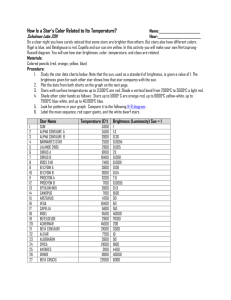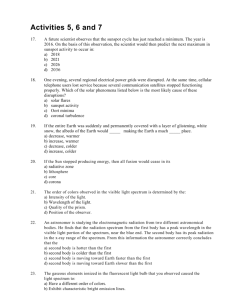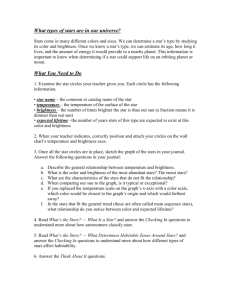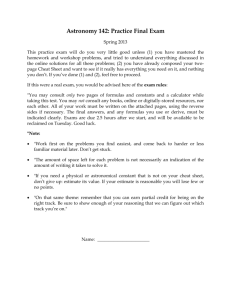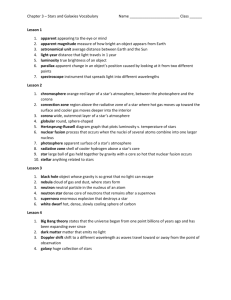Sample Midterm - Physics @ IUPUI
advertisement
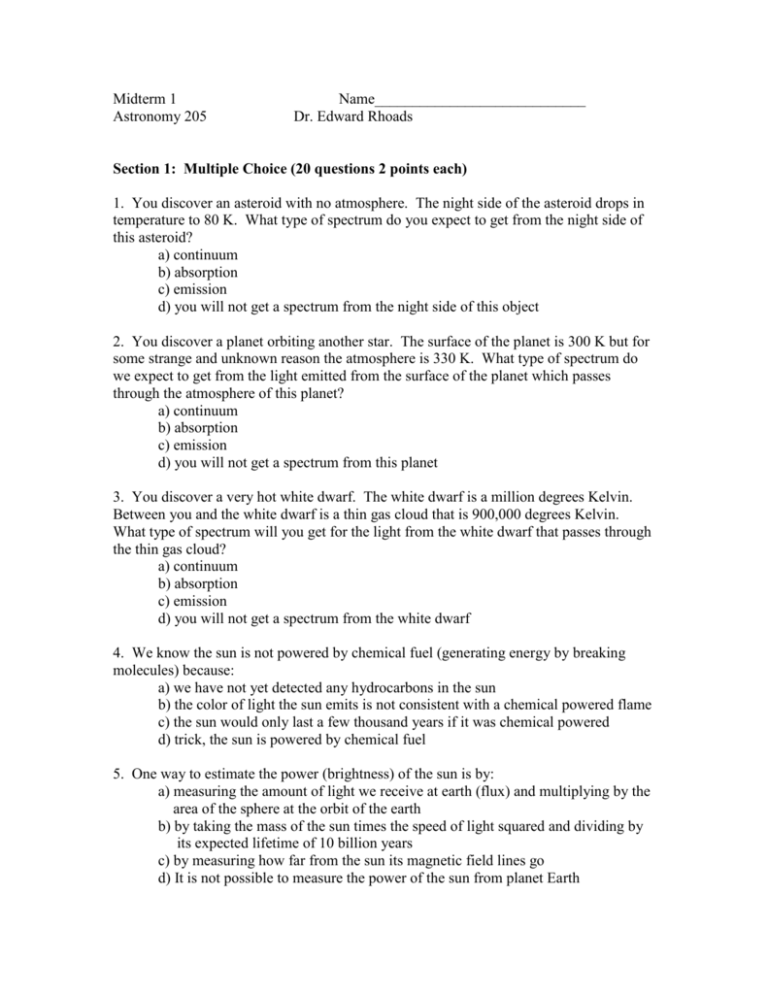
Midterm 1 Astronomy 205 Name____________________________ Dr. Edward Rhoads Section 1: Multiple Choice (20 questions 2 points each) 1. You discover an asteroid with no atmosphere. The night side of the asteroid drops in temperature to 80 K. What type of spectrum do you expect to get from the night side of this asteroid? a) continuum b) absorption c) emission d) you will not get a spectrum from the night side of this object 2. You discover a planet orbiting another star. The surface of the planet is 300 K but for some strange and unknown reason the atmosphere is 330 K. What type of spectrum do we expect to get from the light emitted from the surface of the planet which passes through the atmosphere of this planet? a) continuum b) absorption c) emission d) you will not get a spectrum from this planet 3. You discover a very hot white dwarf. The white dwarf is a million degrees Kelvin. Between you and the white dwarf is a thin gas cloud that is 900,000 degrees Kelvin. What type of spectrum will you get for the light from the white dwarf that passes through the thin gas cloud? a) continuum b) absorption c) emission d) you will not get a spectrum from the white dwarf 4. We know the sun is not powered by chemical fuel (generating energy by breaking molecules) because: a) we have not yet detected any hydrocarbons in the sun b) the color of light the sun emits is not consistent with a chemical powered flame c) the sun would only last a few thousand years if it was chemical powered d) trick, the sun is powered by chemical fuel 5. One way to estimate the power (brightness) of the sun is by: a) measuring the amount of light we receive at earth (flux) and multiplying by the area of the sphere at the orbit of the earth b) by taking the mass of the sun times the speed of light squared and dividing by its expected lifetime of 10 billion years c) by measuring how far from the sun its magnetic field lines go d) It is not possible to measure the power of the sun from planet Earth 6. Even though the Corona of the sun is a million degrees it poses no harm to spacecraft because: a) no spacecraft could ever make it that far b) the Corona is near to the core of the sun which is far hotter c) the Corona is so thin that it does not transfer energy well d) trick the corona would fry and or disintegrate a spacecraft instantly 7. Sunspots are created in places where: a) magnetic fields block light from being emitted b) magnetic fields temporarily keep upwelling material from falling back down c) there is a hole in the sun d) a comet has crashed into the sun and made it very very cold so that no light can be emitted 8. In the convective zone of the sun energy is primarily transferred through: a) radiating it upwards b) conducting it through the material c) moving the material it is in d) none of the above the energy is not transferred 9. While a star is in the process of being born it is called a: a) brown dwarf b) red dwarf c) Main Sequence Star d) protostar 10. As a star is being formed its brightness and effective temperature: a) brightness goes down and the temperature goes up b) brightness goes down and the temperature goes down c) brightness goes up and the temperature goes up d) brightness goes up and the temperature goes down 11. What happens to the high mass stars in an open cluster? a) they die b) they are eaten by black holes c) they separate from the cluster and go their own separate ways d) they stay in the cluster for trillions of years if not longer 12. What happens to the mid to low mass stars in an open cluster? a) they die b) they are eaten by black holes c) they separate from the cluster and go their own separate ways d) they stay in the cluster for trillions of years if not longer 13. If you plot a very large number of random stars on a HR Diagram measuring their apparent magnitude vs. their B-V magnitude what will you get? a) A nice neat plot with a clear main sequence and clear red giant branch b) A nice neat plot with a clear main sequence but a few red giant branches c) A plot with a clear main sequence but an unclear red giant branch d) A complete scatterplot 14. Why would using a cluster of stars in which all the stars are the same distance to plot on an HR diagram be very useful? a) The stars would then all be the same brightness b) The stars would then all be the same color c) Stars with different apparent magnitudes have different absolute magnitudes d) Each star’s apparent magnitude differs from its absolute magnitude by the same amount 15. A cluster of stars which is older will: a) have a bluer turn off point b) have a redder turn off point c) have a main sequence that for some given B-V has a brighter apparent brightness d) have a main sequence that for some given B-V has a dimmer apparent brightness 16. A cluster of stars which is further away will: a) have a bluer turn off point b) have a redder turn off point c) have a main sequence that for some given B-V has a brighter apparent brightness d) have a main sequence that for some given B-V has a dimmer apparent brightness 17. A particular star has a B-V value of 0.9 at a distance of 12 parsecs. If a similar star were to be found at a distance of 1200 parsecs and you ignore absorption of light be dust then what would the B-V value of that star be? a) 90 b) 9 * 10-3 c) 1188.9 d) 0.9 18. In the core of the sun when two Hydrogen nuclei (protons) are on a collision course with each other what happens most of the time? a) they break each other apart leaving only quarks and neutrinos b) they fuse together c) they repel each other d) the core of the sun does not currently contain any Hydrogen 19. Why do small stars tend to do fusion through the p-p chain while large stars use the CNO cycle? a) only the large stars have the carbon needed for the CNO cycle b) the CNO cycle is so highly temperature dependant that only the large stars can effectively do it c) small stars are just more efficient in the fusion process d) small stars have very large convective zones while large stars are mostly a large radiative zone 20. Fusion can occur in the core of the sun because: a) the protons have enough energy to overcome the electric repulsion b) gravity squeezes all of the atoms in the core together to slowly form an ever growing atom c) there is an uncertainty in the positions of the protons which gives them a chance to be in the same place d) trick, fusion does not actually occur in the core of the sun that is a famous myth which has long since been disproven by astronomers Under problem 21 please mark A on the scantron. This is for sorting purposes. Section 2: Short Answer. 40 pts per question lowest score is dropped. 1) For the cluster above (diagram from Alcaino et, 1991, Al, BVRI CCD photometry of the metal-poor globular cluster NGC 4372, AJ, 102, 159A) A) Find and label the main sequence, red giant branch, horizontal branch, and the turn off point. B) If the sun was in the cluster (as viewed from Earth the sun has a B-V of 0.68) label where in the diagram above the sun would be located. Note there may or may not be stars at that location for this cluster. C) distance = 10 parsecs * 10(x/5) where X = V – Mv where the Mv value for the sun is +5. Find the distance to this cluster. D) A rough estimate of the age of this cluster is: 10 billion years * 10(4y/15) where y = Vturnoff – Vsun if the sun was in the cluster. Find the age of this cluster. 2) The above is a spectrum. A) What type of spectrum is this? B) Explain why the spectrum looks the way it does. C) Imagine you have a 15,000 K star. For each of the 3 spectra explain what would be needed so that you can get each of the 3 spectrum. D) Use a sentence or two to explain how and why we know what element the sun is mostly made of. 3) A) In a couple of sentences explain how stars are born. B) Why does the method that stars are born tend to lead to clusters of stars? C) What are the 3 different types of star clusters? D) For each type of star cluster how long do they tend to live? Explain why. 4) A) What does a star have to do to be considered a Main Sequence Star? B) For main sequence stars what is occurring in the core of the star that keeps it stable (try to be a little in depth here)? C) How do stars produce most of the energy that they emit? D) In a few sentences explain why this energy production method is so tough to do even in the core of a star and what 3 conditions are required for it to occur. 5) A) How long does it take energy to go from the bottom of the Sun’s radiative zone to the top? Explain why it takes that long. B) What element is the sun mostly made out of and what phase is the matter of the sun in? C) Explain how magnetic fields play a role on the surface of the sun. Try to give at least 2 examples. D) What is a sunspot? If you looked only at a sunspot would it be bright or dark and why?


